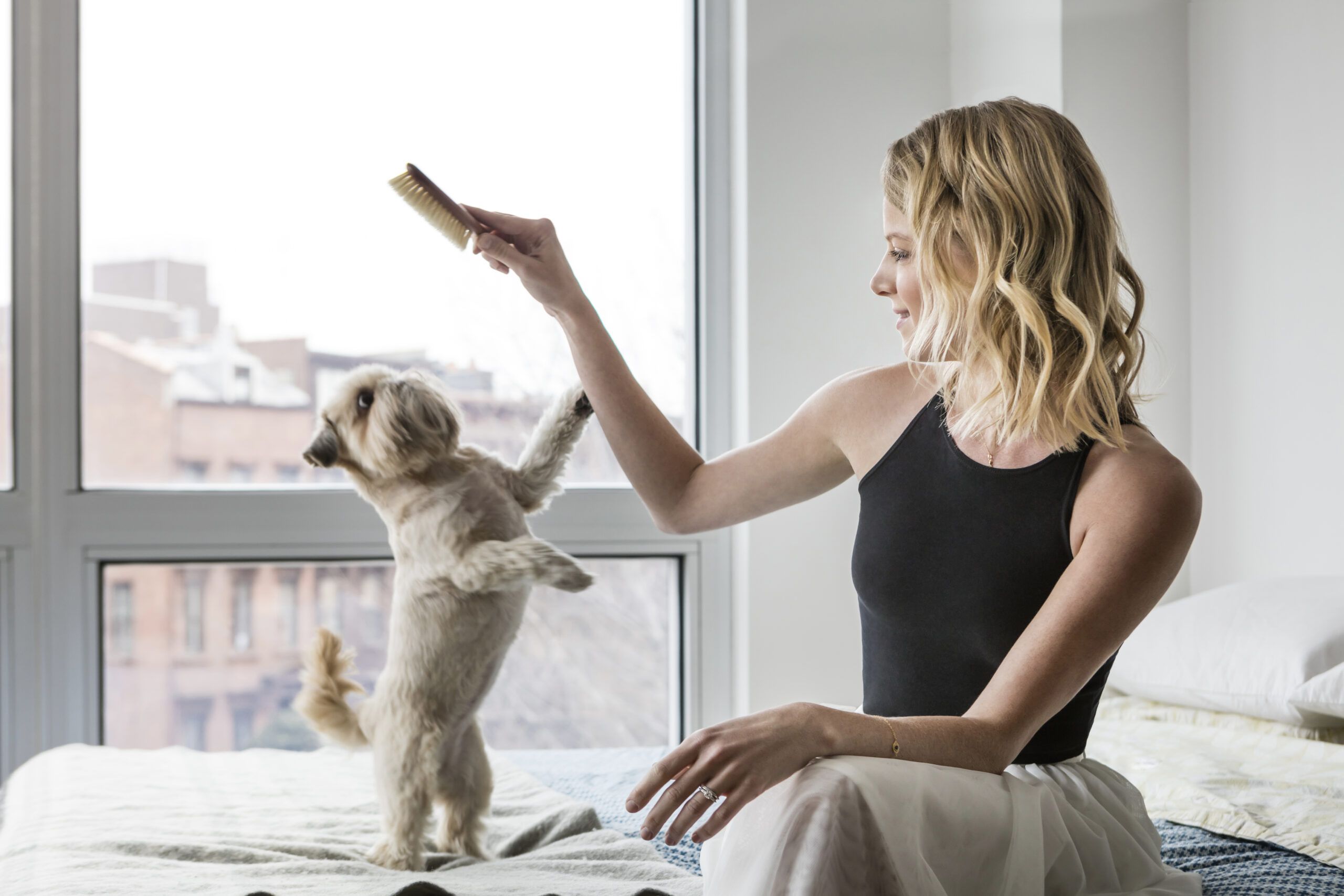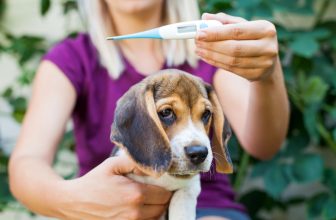
“Not every brush available is the right choice for your dog’s coat,” says dog groomer Claudia Cesarotti. Different dog brushes benefit different coat types based on their length and texture. And yes, even short-haired dogs need regular brushing!
Here’s Dogster’s list of the best dog brushes based on your dog’s coat, plus basic brushing tips from professional groomers.
Best dog brushes: slicker brush for dogs
The slicker brush is the most universal tool for all coat types. A slicker brush has bent metal teeth to grab onto tangles and mats in longer-haired dogs. Look for one that is comfortable for you to use, easy cleaning, has firm metal pins that won’t easily come out plus has the right brush head size for your dog — small, medium or large. For long lasting, get one made from a company with a long record of making top dog grooming supplies.
Use a slicker brush on:
- A long, double coat
- A long and smooth outer coat and a soft and fuzzy undercoat
- Hypoallergenic hair
- Single and some double coats
- Curly, wavy or straight hair
Slicker brushes work best on these breeds:
Poodle, Oodle, Bichon Frise, Shih Tzu, Yorkshire Terrier, Schnauzer, Airedale Terrier, Golden Retriever, German Shepherd Dog, Siberian Husky, Australian Shepherd, Shetland Sheepdog, Bernese Mountain Dog, Great Pyrenees.
Paws up to these three best dog slicker brushes:
- Andis Large and Medium Firm Slicker Brushes: It comes in two sizes, with the large one perfect for bigger pups. Lightweight and durable and includes the soft-grip that makes it comfortable to use. $7/medium and $9/large
- ConairProPet Self-Cleaning Slicker Brush: We like the memory gel-grip handle, self-cleaning button, and bright color so you can find it easily in the dog supplies basket and its firm, metal pins. The medium size works with most dog body types. $16.99
- ConairProPet Small Triangle Slicker: Here’s a slicker brush proportioned for the small pup. The double sided head and extra long pins removed loose hair and tangles from the body and harder to brush delicate areas. Includes a comfortable bubble-gel handle. $15.99

Best dog brush: pin brush for dogs
A pin brush has an oval-shaped head and metal teeth with a tiny plastic ball on each tooth of the brush. Bristles on a pin brush are more spread out than on a slicker brush. Pin brushes remove loose hair and detangle matted or knotted coats. Again, choose one with a comfortable handle, has strong metal pins with heads that won’t hurt your pup and choose the right brush head size for your dog — small, medium or large. For durability, get one made from a company with a long record of making top dog grooming supplies.
Pin brushes are best for dogs with:
- A long, single coat
- A silky, drop coat, straight or curly
- sensitive skin
Pin brushes for dogs work best for these breeds:
Yorkshire Terrier, Shih Tzu, Pomeranian, Schnauzer, and various Collies.
Paws up to these three best dog pin brushes:
- Hartz Groomer’s Best Combo Dog Brush: This affordable two-sided brush gives you both a nylon bristle brush and the pin brush with stainless steel tips and a protective coating. The handle is designed for maximum comfort. $6.79
- Andis Medium and Large Pin Brushes: We like this one for its light weight, comfortable handle and nice bright color to keep it from getting lost in the dog supplies. It comes in both medium and large, so you can choose the best size for your dog. (The medium works for small or medium-sized pups.) It eliminates tangles, loose hair, dirt plus stimulates healthy hair growth. Andis Company is known for its quality grooming supplies. $9/medium or large
- BaBylissPro PET Large, Medium or Small Long-Pin Slicker Brush: The extra-wide head makes this one stand out, especially if you’ve got a lot of brushing to do. Flexible pins penetrate the coat for eliminating matts or fluff drying. Nice, bubble-gel handle to reduce hand fatigue. BaBylissPro is a division of Conair, so it’s got a track record of grooming products. $15.99/large, $14.99/medium and $12.99/small.

Best dog brush: boar bristle brush for dogs
A bristle brush looks similar to the brush you use on your own hair, but for dogs, works best on short hair, says Claudia. Bristle brushes can be made boar bristles, nylon bristles or a mixture of boar and nylon bristles. Find a bristle brush that’s long lasting, gentle on your dog yet comfortable for you to use.
Use a bristle brush or a rubber curry brush on the following coat types:
- Short, double, dense coat.
- Smooth outer coat, soft and fuzzy undercoat. This will be a dog with fur that sheds and only grows out to a short length.
Bristle brushes for dogs work best for these breeds:
Labrador Retriever, Boxer, Beagle, French Bulldog, Chihuahua, Basset Hound, Basenji, Belgian Malinois.
Paws up for these two best dog bristle brushes:
When to use a dog comb
Brush and then comb furry dog ears with a stainless-steel comb. The face needs a precision tool like a comb to groom the delicate areas around the eyes, nose and mouth. Also use a comb to work in conditioner on wet coat to help untangle knots.
Best dog brush tips from professional groomers
We comb through your dog brush FAQs:
-
Should I brush wet or dry dog hair?
Dry. Before brushing your dog’s hair, lightly spray hair with detangling spray. Brushing completely wet can irritate the skin, especially with too much pressure. Use a metal comb or a slicker brush to work in conditioner to remove any knots and tangles while the coat is wet. Use a pet-safe blow dryer after the bath and before brushing.
-
How often should I brush my dog?
It depends on the coat type. Brush short-haired dogs once a week, says Nicole Kalish, education manager at Andis.
“Brushing twice a week is best for dogs with longer coats or with coats that tend to tangle and matt,” she says.
-
How do I brush out matts in my dog’s fur?
“The best way to brush out matted hair is to separate tangles by line-brushing the dog with a slicker brush and always follow through with a stainless-steel comb,” says Nicole.
Use a detangling spray. Dogs have very sensitive skin and it’s easy to nick the skin with scissors. So, a very matted coat should be professionally handled — less stressful for both you and your dog.
-
In what direction to I brush my dog’s coat?
“No matter where you are brushing your dog, always brush in the direction the coat grows,” says Claudia. Brushing against the growth can cause brush burn, a skin irritation.
-
How do I brush my dog’s eyebrows and beard?
Use the edge or the corner of the brush’s surface to safely brush around your dog’s eyes, nose and mouth.
“If a brush seems too bulky or unwieldy, a metal comb is a great tool as it is easier to control with pinpoint precision,” says Claudia.
Why brush your dog?
Brushing your dog is essential for his wellbeing. Regular brushing removes dead skin, helps you identify fleas and ticks and other parasites, distributes your dog’s natural oils and detangles knots that eventually form into painful mats. Bonus: Extra quality time together!
For more grooming advice on maintain fabulous fur, read our article Your Guide to Your Dog’s Fur
<
Credit Source link







